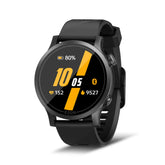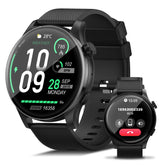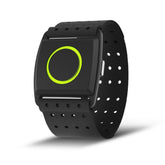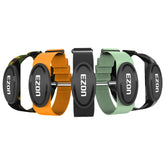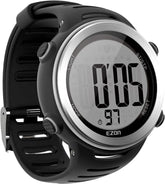Biking Adventures: Enhance Your Ride with Heart Rate and Step Data
Whether you’re chasing Strava KOMs or enjoying weekend rides, combining biking adventures with data from heart rate monitors and step count watches transforms casual pedaling into purposeful progress. This guide reveals how to optimize training, plan epic routes, and ride smarter—no matter your skill level.
1. Training Principles: Ride with Intention, Not Just Instinct
A. Heart Rate Zones: The Key to Balanced Intensity
- Zone 2 (60–70% Max HR): 80% of rides for endurance (e.g., 2–3 hour steady rides) — use a heart rate monitor to maintain a conversational pace (you should be able to speak in full sentences).
- Zone 4 (80–90% Max HR): 10–15% of rides for threshold training (e.g., 5x10-minute efforts at FTP) to boost sustainable power.
- Pro Tip: Post-ride, check heart rate recovery (should drop 20 BPM/min) — slower recovery signals the need for rest.
B. Step Count Watch: Track Cadence and Distance
- Cadence Control: Aim for 80–100 RPM to reduce knee strain—your watch’s real-time cadence data helps you maintain efficiency, especially on climbs.
- Distance Tracking: Use GPS to log weekly mileage, gradually increasing by 10% to avoid overtraining (e.g., 100 miles → 110 miles next week).
2. 8-Week Training Plan for All Riders
Phase 1: Base Building (Weeks 1–2)
- Goal: Build aerobic fitness and pedal efficiency.
-
Key Rides:
- Easy Rides: 60–90 minutes at Zone 2, focusing on smooth pedal strokes and relaxed posture.
- Cadence Drills: 10-minute high-cadence intervals (110–120 RPM) to improve neuromuscular coordination.
- Wearable Insight: Use a step count watch to track daily activity—aim for 5,000–7,000 steps on non-riding days for active recovery.
Phase 2: Strength & Intensity (Weeks 3–5)
- Goal: Increase power output and hill-climbing ability.
-
Key Rides:
- Hill Repeats: 6x5-minute climbs at 110% FTP (Functional Threshold Power), using heart rate data to ensure you’re in Zone 4.
- Tempo Rides: 45 minutes at 85% FTP, practicing steady effort and deep breathing.
- Data Focus: Analyze average cadence and power output in post-ride stats to identify weak spots (e.g., low cadence on flats).
Phase 3: Peak Performance (Weeks 6–8)
- Goal: Simulate race conditions and refine pacing.
-
Key Rides:
- Long Ride with Intervals: 3-hour ride including 4x20-minute efforts at race pace, using your watch’s route mapping to include varied terrain.
- Time Trial Simulation: 20K all-out effort to test FTP and practice aero position—review heart rate variability (HRV) post-ride to gauge stress.
- Recovery Priority: Use your heart rate monitor to schedule rest days when HRV drops or resting heart rate rises 5 BPM.
3. How Wearables Elevate Every Ride
A. Real-Time Data for Instant Adjustments
- Pace Alerts: Set target speed for flat sections (e.g., 25 km/h) and let your watch vibrate if you’re off track—critical for group rides or time trials.
- Elevation Tracking: Receive real-time alerts for steep climbs (e.g., “10% grade ahead—shift to easy gear”) to conserve energy.
B. Training Load Analysis
- Weekly Stress Score: Watches calculate cumulative training load—aim for a gradual increase to avoid burnout (e.g., 300 TSS → 330 TSS week-over-week).
- Sleep Staging: Ensure 7–9 hours of sleep with 15% deep sleep for muscle repair—use watch insights to adjust bedtime routines (e.g., avoid screens 1 hour pre-bed).
C. Route Planning with GPS Precision
- GPX File Support: Download routes from Komoot or Ride with GPS to your step count watch, complete with turn-by-turn navigation.
- Offline Maps: Preload trail maps for remote rides—never get lost on backcountry single tracks.
4. Route Planning Tips for Unforgettable Adventures
A. Terrain Mix for Well-Rounded Fitness
- Road Riders: Plan routes with 70% flat terrain for speed and 30% hills for strength (use watch GPS to measure elevation gain).
- Mountain Bikers: Include technical sections (rock gardens, switchbacks) to improve handling, logging bike-specific metrics like jump count (if supported).
B. Safety and Logistics
- Weather Alerts: Use your watch to check real-time forecasts—avoid riding in thunderstorms or extreme heat.
- Emergency Features: Activate “live tracking” to share your route with contacts, the ultimate safety net for solo adventures.
C. Post-Ride Analysis
- Power vs. Heart Rate: Compare these metrics to identify if you’re relying too much on effort (high heart rate, low power = inefficient pedaling).
- Calorie Burn Accuracy: Sync with MyFitnessPal to ensure you’re refueling adequately (e.g., 1,500 calories burned on a long ride = 50g protein post-ride).
5. Common Mistakes to Avoid
- Ignoring Recovery Days: Use HRV data to detect overtraining—low HRV means swap a hard ride for a casual spin.
- Neglecting Cadence: A cadence below 70 RPM increases knee strain—let your watch’s real-time feedback correct this habit.
- Underestimating Route Difficulty: Always check elevation profiles in your watch’s route planner to avoid mid-ride exhaustion.
6. Gear Recommendations for Every Rider
A. Heart Rate Monitor Features
- Chest Strap vs. Wrist-Based: Chest straps (e.g., Polar H10) for max accuracy during sprints; wrist-based (EZON Heart Rate Series) for everyday convenience.
- HRV Analysis: Look for watches that calculate stress scores to balance training and rest.
B. Step Count Watch Essentials
- Multi-Band GPS: EZON GPS Series for reliable tracking in dense forests or urban canyons.
- Battery Life: 40+ hours in GPS mode for multi-day bike tours—no mid-ride charging needed.
C. Bonus Gear
- Aero Bars: Pair with your watch’s pace data to maintain optimal position during time trials.
- Power Meter: Sync with your watch to measure watts and refine FTP estimates.
7. Sample Weekly Training Schedule
| Day | Ride Type | Wearable Use |
|---|---|---|
| Monday | Easy Recovery Ride | Monitor heart rate to stay in Zone 1–2, track cadence |
| Tuesday | Hill Repeats | Heart rate zone alerts for 110% FTP efforts |
| Wednesday | Rest or Core Training | Log steps and monitor HRV for recovery status |
| Thursday | Tempo Ride | Pace alerts to maintain 85% FTP, analyze power data |
| Friday | Skills Practice | Cadence tracking on technical terrain, map routes |
| Saturday | Long Endurance Ride | GPS route planning, fueling reminders (every 60 mins) |
| Sunday | Rest or Social Ride | Casual ride with friends, no stress on metrics |
8. FAQs: Your Biking Data Questions Answered
Q: How do I calculate my FTP?
- Do a 20-minute all-out effort; your FTP = 95% of the average power (or heart rate) from that effort—most watches calculate this automatically.
Q: Can I use a step count watch for mountain biking?
- Yes! Look for rugged models (10ATM water resistance, shockproof) like EZON GPS Series, which track elevation, jump force, and trail difficulty.
Q: How often should I replace my heart rate monitor?
- Chest straps last 3–5 years; wrist-based sensors may need calibration annually—check battery life and signal strength regularly.
Ride Smarter, Explore Further
With heart rate monitors and step count watches as your copilots, every ride becomes a chance to learn, improve, and explore. Use data to refine training, plan epic routes, and stay safe, turning every pedal stroke into progress.
Whether you’re chasing personal bests or simply enjoying the freedom of the open road, let technology enhance your biking adventures. Gear up, hit the trail, and ride with the confidence that comes from training with precision, not guesswork.
EZON Watch: Professional sports technology brand
https://ezonwatch.com
https://ezonwatch.com
